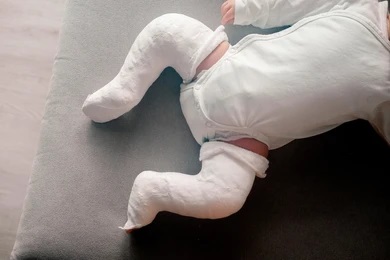Consulting Hours:
- 05:30pm to 08:00pm (Mon to Sat) - Little Bones Clinic, Sector 45 Noida
- 09:00am to 04:30pm (Mon to Sat) - Amrita Hospital, Faridabad
Appointment:
- Pediatric Orthopaedics
- Ankle & Foot (All ages)
- Deformities & Disabilities (All ages)
CTEV correction by Ponseti Method of Casting

What are the symptoms of CTEV?
- One or both feet are turned inward and downward.
- The foot appears small and has a rigid, abnormal shape.
- Difficulty in moving the foot or walking normally.
What is CTEV correction by Ponseti method of casting?
CTEV correction by Ponseti method of casting is a non-surgical approach used to treat Congenital Talipes Equinovarus (CTEV), commonly known as clubfoot. It involves a series of plaster casts applied to gradually correct the foot deformity. This method is named after Dr. Ignacio Ponseti, who developed it to gently reposition the foot into a normal alignment.
What are the causes of CTEV?
- Genetic factors or family history of the condition.
- Abnormal positioning of the fetus in the womb.
- Potential disruptions in the development of the foot and ankle during pregnancy.
How is CTEV treated using the Ponseti method?
- Initial casting: Soft plaster casts are applied to gradually correct the foot’s position.
- Weekly cast changes: Each week, the casts are changed to further adjust the foot’s alignment.
- Achilles tendon release: In some cases, a minor surgical procedure may be performed to lengthen the Achilles tendon if necessary.
- Follow-up with bracing: After the casting phase, braces are used to maintain the corrected position and prevent relapse.
Treatments
CTEV correction by Ponseti method of Casting
CTEV recurrence correction
Tendon transfer surgeries
Minimally invasive soft tissue and bony surgeries for CTEV
Flat foot
Foot and ankle malalignment
IF YOU NEED A DOCTOR ? MAKE AN APPOINTMENT NOW!
Need a doctor? Don’t wait! Schedule an appointment now for expert medical care tailored to your needs. Our experienced professionals are ready to help you achieve optimal health and well-being. Book your visit today!
Dr. Pritish Singh at Little Bones Clinic in Noida is a highly skilled Paediatric Orthopaedic and Deformity Correction Surgeon.
Contact Info
Our Services
Limb lengthening’s
Software guided deformity corrections
Quick Links
Dr. Pritish Singh
Outstation OPDs
Success Story
OPD Locations
OPD Timings
Outreach OPDs
Sheetal Hospital, Palwal
Every 2nd & 4th Thursday
2:00 pm -4:00 pm
Address
- Little Bones Clinic FF - 06, AMRAPALI SAPPHIRE, St 1, Sadarpur, Sector-45, Noida, Uttar Pradesh 201303
- Amrita Hospital, Paediatric Orthopaedics & Deformity Correction OPD, Faridabad, Haryana 121002
Copyright © 2024 Little bones All Right Reserved. Designed by  PromotionAdda
PromotionAdda
 PromotionAdda
PromotionAdda 

